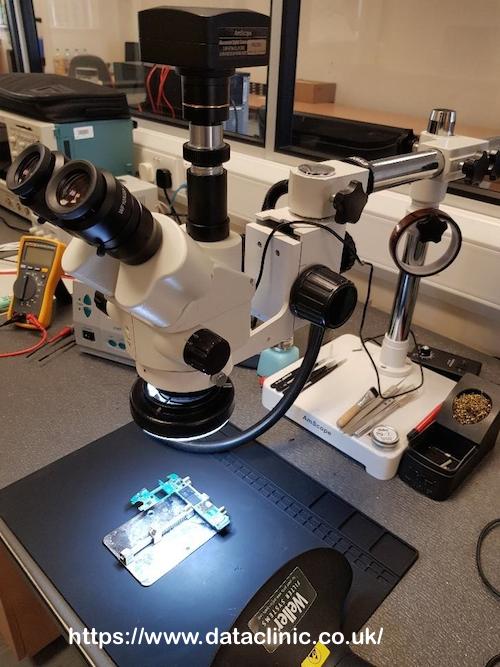Mobile phone data recovery is the process of salvaging data from failed storage devices, at Data Clinic we offer our services across a wide range of devices. Here we will look at our mobile phone side of the company, more specifically what is known as a chip-off operation.
With any mobile phone or tablet that Data Clinic receive, we initially attempt to inspect the phone, we determine if the failure is with the peripheral components such as batteries, charging ports and screens. If this is the case, then we wouldn’t need to go any further. For a lot of cases however, this option serves as a process of elimination and if this first attempt of recovering the data is unsuccessful then we look at the more advanced options available to us. This is typically in the form of advanced micro soldering, JTAG or a Chip-Off operation.
So, what is a ‘Chip-Off’?
A Chip-off is the process of de-soldering the Flash Memory chip from the failed phone / tablet in the hope that we will successfully read its raw data independent of the device.
How to… Chip-Off recovery?
Once we have determined that a Chip-Off on a phone / tablet is needed then the next step is preparation. The phone must be fully dismantled, including the removal of any protective metal heat shields.When this is done we identify the eMMC (or NAND) memory chip place the PCB into a special holder underneath our stereo microscope as shown here.
What is now needed to remove any underfill from around the memory chip and add specialist flux to the chip. The Flux we typically use is Amtech Tacky Flux – the idea with this is to dispense it all around the chip then apply heat to it.
The main heat application we use is a Quick 861DA heat gun. This is a station that offers a wide range of options when it comes to applying heat. We make sure to select a correct temperature, airflow and nozzle to do the job properly.
Once the chip has been lifted from the board after carefully applying the correct amount of heat we get the de-soldered chip, we then proceed to cleaning and re-balling the chip. This is a meticulous process whereby we need to ensure that each of the 100+ solder contacts have clean solder. It is a manual process that you need skill in precision soldering and a keen eye under the microscope to do.
Once each pin has been successfully and soldered in a uniform manner, it is time to clean it up with specialist chemical solutions. This ensures that the contacts are as clean as they can be and thus the read of the chip should also be good!
There are a lot of readers and programmers available worldwide that you can use to read the raw data of an eMMC NAND memory chip. The honest answer is they all have different capabilities for different chips. Its not a case of one is the best. Here are some samples of these available ‘boxes’.
Once the data is fully dumped to a binary image file, we then analyse and decode the raw data. Once reconstructed we can send our customer a summary to let them know the recovery statistics as shown below.
This data can then easily be transferred to another storage device (typically a memory stick) and returned to the customer.
In summary…
Here at Data Clinic we love reuniting customers with data that they thought was lost. A chip-Off is one of the procedures that really is a last resort. Chip-off cases are applicable when:
- The logic board is too severely damaged to repair
- The lock on a phone if it is not known and there is no method of bypassing it via software
- Corrosion cannot be decontaminated
- For deleted data
The art of performing a chip-off is something that we pride ourselves on being able to achieve, we have recovered the data from many phones where this was the only option and are still carrying out these procedures today.


